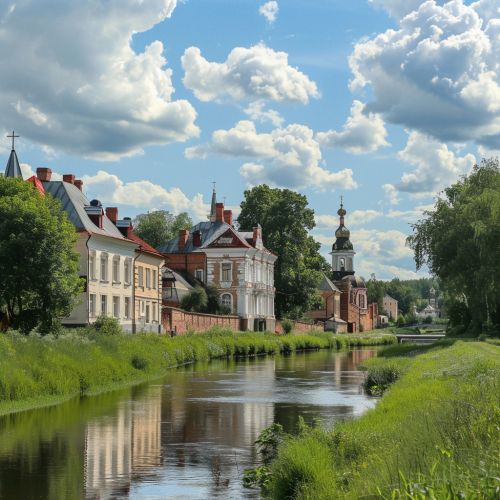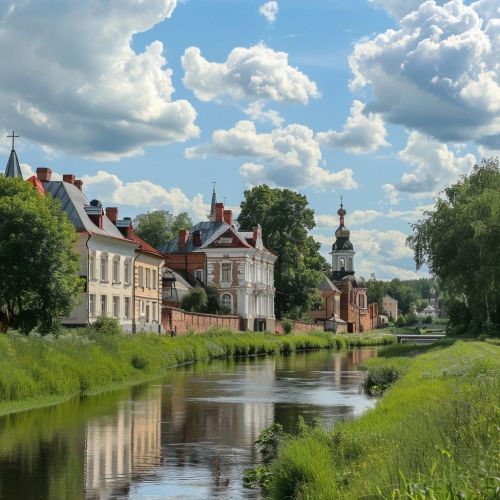Torzhok
History
Torzhok, a town in Tver Oblast, Russia, has a rich history dating back to the early medieval period. It was first mentioned in the chronicles in 1139 as a significant trading post on the route from Novgorod to the Volga River. The town's name, derived from the Russian word "торг" (torg), meaning "trade," underscores its historical role as a commercial hub.
During the 12th and 13th centuries, Torzhok was a part of the Novgorod Republic, serving as a vital link in the trade network between Novgorod and the Volga region. The town's strategic location made it a target for various military campaigns, including the Mongol invasion in the 13th century. Despite these challenges, Torzhok managed to thrive, becoming an important center for craft and trade.
In the 15th century, Torzhok came under the control of the Grand Duchy of Moscow. This period marked significant growth and development for the town, as it became an essential part of the Muscovite state. The construction of stone fortifications in the 16th century further solidified its importance as a defensive stronghold.


Geography and Climate
Torzhok is situated on the banks of the Tvertsa River, approximately 60 kilometers west of Tver, the administrative center of Tver Oblast. The town's geographical coordinates are 57°02′N latitude and 34°58′E longitude. The Tvertsa River, a tributary of the Volga, has played a crucial role in the town's development, providing a natural transportation route and supporting local agriculture.
The climate in Torzhok is classified as a humid continental climate, characterized by cold winters and warm summers. The average temperature in January, the coldest month, is around -10°C, while in July, the warmest month, it averages 18°C. Precipitation is relatively evenly distributed throughout the year, with an annual average of approximately 600 millimeters.
Economy
Historically, Torzhok's economy was primarily based on trade and crafts. The town was known for its skilled artisans, particularly in the fields of leatherworking, metalworking, and embroidery. The famous Torzhok gold embroidery, known as "zlatoglavie," has been a significant cultural and economic asset for the town.
In the modern era, Torzhok's economy has diversified. While traditional crafts remain an essential part of the local economy, other sectors such as manufacturing, agriculture, and tourism have gained prominence. The town's strategic location near major transportation routes, including the M10 highway and the Oktyabrskaya Railway, has facilitated economic growth and development.
Architecture and Landmarks
Torzhok is renowned for its well-preserved historical architecture, which reflects its rich cultural heritage. The town boasts numerous churches, monasteries, and other historical buildings, many of which date back to the medieval period.
One of the most notable landmarks is the Borisoglebsky Monastery, founded in the 12th century. The monastery complex includes several churches, including the Cathedral of Saints Boris and Gleb, which features stunning frescoes and iconography. Another significant architectural site is the Transfiguration Cathedral, built in the 18th century in the neoclassical style.
The town's historical center, with its narrow streets and traditional wooden houses, offers a glimpse into the past. The local museum, housed in a former merchant's mansion, provides valuable insights into the town's history, culture, and crafts.
Culture and Traditions
Torzhok has a rich cultural heritage, deeply rooted in its history and traditions. The town is famous for its traditional crafts, particularly gold embroidery, which has been practiced for centuries. The intricate designs and high-quality craftsmanship of Torzhok embroidery have made it a sought-after art form, both in Russia and internationally.
The town hosts several cultural events and festivals throughout the year, celebrating its history and traditions. One of the most notable events is the annual Torzhok Embroidery Festival, which showcases the work of local artisans and attracts visitors from across the country. Other cultural events include folk music and dance performances, historical reenactments, and traditional fairs.
Education and Research
Torzhok is home to several educational institutions, ranging from primary schools to specialized vocational schools. The town's educational system emphasizes the importance of preserving and promoting traditional crafts, with several schools offering courses in embroidery, metalworking, and other artisanal skills.
In addition to its educational institutions, Torzhok is also a center for historical and cultural research. The local museum and historical society conduct research on the town's history, culture, and crafts, contributing valuable knowledge to the broader academic community. The town's archives contain a wealth of historical documents, providing valuable resources for researchers and historians.
Transportation
Torzhok's strategic location has made it an important transportation hub throughout its history. The town is well-connected by road and rail, facilitating the movement of goods and people.
The M10 highway, which connects Moscow and Saint Petersburg, passes near Torzhok, providing easy access to these major cities. The Oktyabrskaya Railway, one of the oldest and most important railway lines in Russia, also serves the town, offering regular passenger and freight services.
Local transportation within Torzhok includes buses, taxis, and private vehicles. The town's compact size and well-maintained roads make it easy to navigate, whether by car, bicycle, or on foot.
Demographics
As of the latest census, Torzhok has a population of approximately 45,000 residents. The town's population has remained relatively stable over the past few decades, with a slight decline due to urban migration and demographic trends.
The majority of Torzhok's residents are ethnic Russians, with small communities of other ethnic groups, including Ukrainians, Belarusians, and Tatars. The town's cultural diversity is reflected in its traditions, cuisine, and festivals.
Notable Residents
Torzhok has been home to several notable figures throughout its history. One of the most famous residents was the Russian poet and writer Alexander Pushkin, who visited the town several times and mentioned it in his works. Another notable figure was the Russian painter Alexei Venetsianov, who lived and worked in Torzhok, capturing its landscapes and people in his art.
